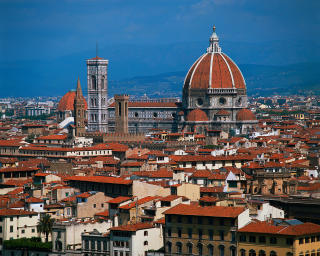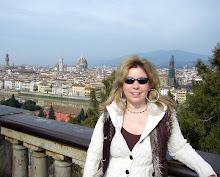 On Monday, April 2, Chip and I joined a group of students on a walking tour, part of the study abroad Cultural Calendar. This one had an intriguing title, “The Untold Tales of Florence,” inspiring us to tag along. We weren’t disappointed.
On Monday, April 2, Chip and I joined a group of students on a walking tour, part of the study abroad Cultural Calendar. This one had an intriguing title, “The Untold Tales of Florence,” inspiring us to tag along. We weren’t disappointed. The walking tour was led by Angela, probably every student’s favorite guide. She’s witty, funny, and exuberant, making her the perfect person to tell us the sordid and little-known tales of Florence’s past.
The walking tour was led by Angela, probably every student’s favorite guide. She’s witty, funny, and exuberant, making her the perfect person to tell us the sordid and little-known tales of Florence’s past.Along the way we learned saw the very spot where the gilt copper ball that adorns the top of Brunelleschi’s Dome fell when it was struck by lightening during a severe storm on July 17, 1600 (fortunately, no one was injured, which is a miracle in itself).
 Doing what the Florentines do best, they decided to replace it with an even larger copper ball. Now there’s optimism!
Doing what the Florentines do best, they decided to replace it with an even larger copper ball. Now there’s optimism!We also heard the story of an unfortunate man who once, in a fit of anger, threw horse dung at a Madonna that was encased in a Tabernacle on the side of a building
 (approximately 1,200 of these adorn the walls throughout Florence, once serving as places of worship for the poorer neighborhoods). His punishment for this offense? Death, naturally. You just don’t mess with religion in this town!
(approximately 1,200 of these adorn the walls throughout Florence, once serving as places of worship for the poorer neighborhoods). His punishment for this offense? Death, naturally. You just don’t mess with religion in this town! She took us to a small hidden courtyard that is said to be haunted by a young woman who makes her appearance on the first Tuesday of every month. What timing! Many students quickly made plans to return the next night.
She took us to a small hidden courtyard that is said to be haunted by a young woman who makes her appearance on the first Tuesday of every month. What timing! Many students quickly made plans to return the next night. We visited Orsanmichele, a former granary that now serves as a church, making the structure quite unique. It is known as “the church of the guilds”; instead of being decorated by statues of religious people, which is the norm, the outside of the church contains a series of tabernacles, each containing the patron saint of a guild. Included are guilds representing cloth merchants, the court of commerce, judges and notaries, butchers, tanners, stone and wood carvers, gunsmiths, bankers and moneychangers, wool workers, flaxmakers, furriers, physicians and pharmacists, silk and goldsmiths, and blacksmiths. Angela focused on the later tabernacle, sharing a story of how the blacksmiths waited for a miracle before they would donate to the church. They got it in the form of a horse, whose entire hoof miraculously flew off as it was being shoed.
We visited Orsanmichele, a former granary that now serves as a church, making the structure quite unique. It is known as “the church of the guilds”; instead of being decorated by statues of religious people, which is the norm, the outside of the church contains a series of tabernacles, each containing the patron saint of a guild. Included are guilds representing cloth merchants, the court of commerce, judges and notaries, butchers, tanners, stone and wood carvers, gunsmiths, bankers and moneychangers, wool workers, flaxmakers, furriers, physicians and pharmacists, silk and goldsmiths, and blacksmiths. Angela focused on the later tabernacle, sharing a story of how the blacksmiths waited for a miracle before they would donate to the church. They got it in the form of a horse, whose entire hoof miraculously flew off as it was being shoed. At Palazzo Vecchio Angela showed us an engraving in the stone that is supposedly done by Michelangelo. He was not pleased with the light sentence given a fellow Florentine and felt that he should be forever remembered for his crime. The result is an amazing caricature that is still visible today.
At Palazzo Vecchio Angela showed us an engraving in the stone that is supposedly done by Michelangelo. He was not pleased with the light sentence given a fellow Florentine and felt that he should be forever remembered for his crime. The result is an amazing caricature that is still visible today. We saw an unusual plaque marking the water line from an earlier flood in Florence. What makes this different from others you see scattered about the city is that a hand with an extended finger points out the level to which the water rose.
We saw an unusual plaque marking the water line from an earlier flood in Florence. What makes this different from others you see scattered about the city is that a hand with an extended finger points out the level to which the water rose. Look closely!
Look closely! Finally we saw an olive tree that was planted to memorialize those who were killed in a Mafia bomb attack, which took place near the Uffizi in 1993. The olive tree, of course, is a sign of peace, making this memorial extremely touching.
Finally we saw an olive tree that was planted to memorialize those who were killed in a Mafia bomb attack, which took place near the Uffizi in 1993. The olive tree, of course, is a sign of peace, making this memorial extremely touching.We all thoroughly enjoyed Angela’s tour about the untold tales of Florence. These are things you just don’t find in the guide books!


1 comment:
Carolyn, thank you for the wonderful reminder of being in Florence. I have a picture of the olive tree that was planted for the memorial and wanted a story put with it. Taking the walking tour with you was like being back there again.
Post a Comment